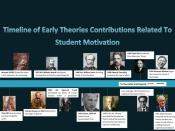The Role of extrinsic reward in human motivation Contents 1. Definition 2 2. The relationship between extrinsic rewards and motivation 3 3. Different factors that may influence the correlation between extrinsic reward and motivation 4 4. Different pay systems and their potential consequences 5-6 5. Conclusion 6 References 7 1. Definition Human behavior can be motivated by many different rewards, including pay, praise, promotion, alleviation of boredom, a sense of accomplishment, etc. Recently, such rewards often have been characterized as of two types: intrinsic rewards and extrinsic rewards.
It has been shown that there is no obvious definitional separation of intrinsic and extrinsic rewards. O??Leary and O?Leary define intrinsic rewards as those which are ?natural? to the situation in which a rewarded task is performed, and extrinsic rewards as those not ordinarily available in a given situation. Another definitional perspective involves the role of others. Rewards, obtained as a function of another individual, are defined as extrinsic, while those, which are not socially mediated, are defined as intrinsic.
Greller and Herold (1975) indicate that there are at least five sources, which the recipient relies upon: the supervisor, co-workers, formal performance appraisals, one?s self, and the task itself.
?Intrinsic rewards derive from the task itself and refer to feelings of competence, achievement, responsibility, challenge, accomplishment and independence. Extrinsic rewards derive from the environment surrounding the task or work (and as such are) associated with the context of the task or job? (Dyer & Parker, 1975). They include financial incentives (Main-stone & Bowen, 1977), working conditions and task feedback. It is assumed that the organization or agent of the organization controls such rewards? (Dyer & Parker 1975). This definitional perspective is the most popular and has been adopted, at one time or another, by many.
2. The relationship between extrinsic...


